Introduction
Link to the Report : The UNESCO Unveiled
UNESCO, short for the United Nations Educational, Scientific and Cultural Organization, is a specialized agency of the United Nations. Established in 1945, its fundamental purpose is to promote international cooperation in the fields of education, science, culture, and communication.
Ij-Reportika presents to you a comprehensive report which aims to shed light on the organization’s intriguing past and its current controversies, providing an in-depth analysis of key areas of focus.
In recent times, the relationship between UNESCO and China has been a subject of growing interest and scrutiny. Chapter One examines the dynamics of the UNESCO-CHINA alliance, encompassing various aspects such as increased funding, the presence of Chinese personnel in top management roles, the controversial blockade of Taiwan’s participation, and the alleged rewriting of history to suit China’s narrative. Moreover, we analyze China’s rising influence within UNESCO and the ensuing reactions from other global players, most notably the USA, as they gear up to counter China’s actions within the organization. Additionally, we explore the controversies surrounding the publication “The UNESCO Courier” and UNESCO’s handling of intangible cultural heritage, particularly the inclusion of Sowa Rigpa and Traditional Chinese Medicine (TCM) in the list of Intangible Cultural Heritage.
Chapter two takes a deep dive into UNESCO’s tumultuous history, unearthing significant controversies that have shaped its reputation over the years. We scrutinize UNESCO’s involvement in conflicts such as the Israel-Palestine dispute, the Palestinian youth magazine controversy, and the Islamic University of Gaza controversy. Furthermore, we investigate instances of corruption within the organization and explore the contentious issue of the New World Information and Communication Order. The report also delves into UNESCO’s role in mediating the Kurdish-Turkish conflict, assessing the challenges faced and the outcomes achieved.
The UNESCO-CHINA Alliance
China has been increasing its influence in UNESCO in recent years. This is evident in a number of ways, including:
Increased funding
China is now the largest contributor to UNESCO’s annual budget, providing around $65 million. This gives China a significant say in how UNESCO’s resources are allocated.
People in top management
China has several people in top management positions at UNESCO, including Xing Qu, who is the deputy director general. This gives China a strong voice in decision-making at the agency.
Qian Tang: Qian Tang is the President of the UNESCO International Bureau of Education. The International Bureau of Education is a specialized agency of UNESCO that is responsible for promoting education around the world. Qian Tang has been a strong advocate for China’s educational policies in UNESCO. She has worked to promote China’s experience in education and to ensure that China’s voice is heard in the organization’s decision-making process.

Zhang Xu: Zhang Xu is the Ambassador and Permanent Delegate of China to UNESCO. He is responsible for representing China’s interests in the organization. Zhang Xu has been a strong advocate for China’s cultural heritage in UNESCO. He has worked to promote China’s World Heritage sites and to ensure that China’s voice is heard in the organization’s decision-making process.
Blockade of Taiwan
China has consistently blocked Taiwan’s attempts to become a member of UNESCO. This is seen by many as an attempt to undermine Taiwan’s sovereignty.

Rewriting the History of China
Ij-Reportika discovered that UNESCO has published several articles and reports mentioning them as parts of China. Download the complete report to know more. The UNESCO Unveiled
China’s Influence in the recent times
The following are some examples from UNESCO’s official website that illustrate China’s influence in the organization:
- In 2018, China hosted the 40th session of the UNESCO General Conference. This was the first time that China had hosted the conference since 1980.
- In 2019, China launched the “Silk Roads: Roads of Dialogue” initiative, which is a UNESCO-led project to promote cultural cooperation along the ancient Silk Road.
- In 2020, China was elected to the UNESCO Executive Board for a four-year term.
- In 2023, the United Nations celebrated Chinese Language Day on April 18 at the UNESCO Headquarters in Paris, France. The theme of the 2023 event, “Chinese Wisdom for a Green World,” reflected China’s growing influence in the multilateral body.
Vice Minister of Education and Director of the Chinese National Commission for UNESCO Chen Jie the event emphasized the importance of Chinese as a medium for China to participate in international cooperation and its positive role in promoting cultural exchange and people-to-people connections.
During the event, China’s Permanent Representative to UNESCO, Yang Jin, highlighted the importance of the Chinese language in international cooperation and cultural exchange. Tawfik Jelassi, UNESCO Assistant Director-General for Communication and Information, emphasized that Chinese is not only a language but also a window into unique ways of thinking, culture, history, and centuries of civilizational exchange.
French writer Nicolas Idier mentioned that the French government places great importance on Chinese language education, with over 40,000 French middle school students learning Chinese between 2022 and 2023.
Check out the report on how the USA is gearing up to counter China in UNESCO: The UNESCO Unveiled
Controversial Publication: The UNESCO Courier
Created in 1945, The UNESCO Courier magazine states its mission to “promote UNESCO’s ideals, maintain a platform for the dialogue between cultures and provide a forum for international debate”. UNESCO has been accused of publishing its Courier, with a bias toward promoting the Belt and Road Initiative (BRI) and China’s interests. The magazine’s content consistently emphasizes the benefits and positive aspects of the BRI while downplaying or overlooking potential concerns or criticisms. Through articles, interviews, and opinion pieces, the Courier portrays China’s involvement in the BRI as a catalyst for economic growth, infrastructure development, and connectivity, often presenting a narrative that aligns with China’s strategic goals.

Following are some of the controversial pages from the UNESCO Courier publication: Tales of Silken Times.
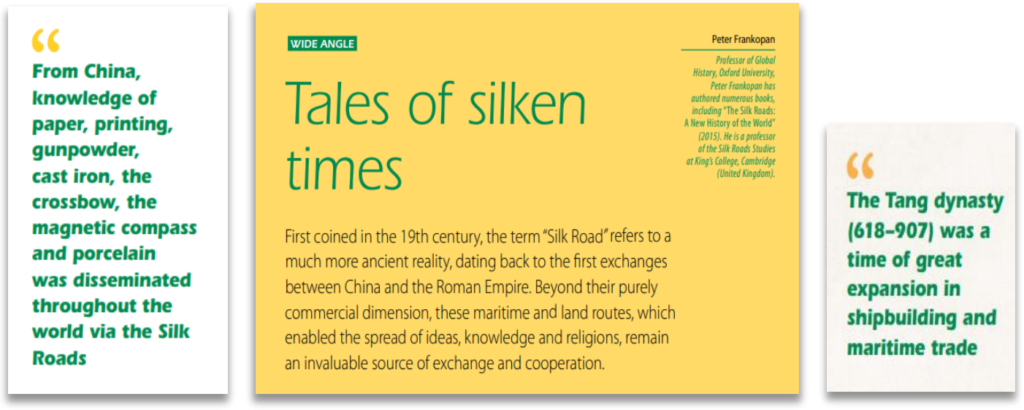
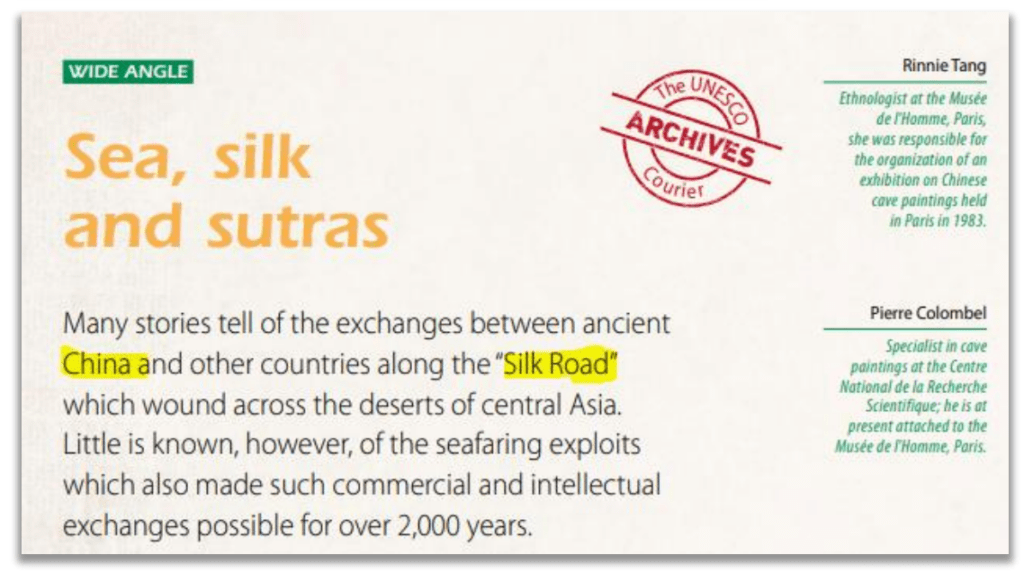
Intangible Cultural Heritage
UNESCO established its list of Intangible Cultural Heritage with the aim of ensuring the better protection of important intangible cultural heritages worldwide and creating awareness of their significance. It aims to draw attention to the importance of safeguarding intangible heritage. Following UNESCO’s 2003 Convention for the Safeguarding of the Intangible Cultural Heritage, this list has been classified into five broad domains in which intangible cultural heritage is manifested:
- Oral traditions and expressions, including language as a vehicle of the intangible cultural heritage
- Performing arts
- Social practices, rituals, and festive events
- Knowledge and practices concerning nature and the universe
- Traditional craftsmanship
Article 36 of the Law of the People’s Republic of China on Intangible Cultural Heritage(Link) states that “The State encourages and supports the citizens, legal persons and other organizations to set up display premises and inheritance premises for intangible cultural heritage and exhibit and inherit the representative items of intangible cultural heritage in accordance with the law.”
China’s expanding influence and keen interest in intangible cultural heritages raise concerns about the underlying motivations and potential consequences. As China takes center stage in promoting and safeguarding its intangible cultural heritage, there are apprehensions about the prioritization of political and economic gains over genuine cultural preservation.
Critics argue that China’s efforts in this domain are primarily driven by a desire to assert dominance, enhance its global image, and extend its soft power influence. By strategically leveraging its cultural heritage, China aims to shape narratives, control the discourse, and gain a greater say in UNESCO.
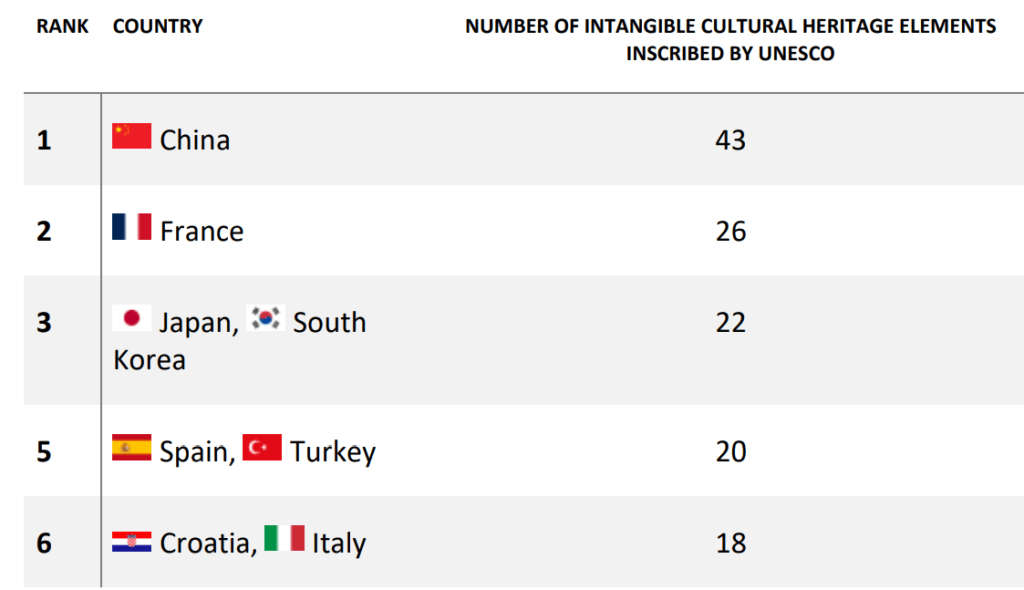
This growing influence enables China to manipulate the understanding and recognition of intangible cultural heritages, potentially sidelining other diverse and equally valuable cultural expressions from around the world. Furthermore, China’s active involvement in ICH can lead to the commodification of cultural practices, the dilution of authenticity, and the erosion of local traditions in the pursuit of economic gains. Such concerns cast doubt on China’s true intentions and raise questions about the long-term impact of its growing influence in the realm of intangible cultural heritage.
Inclusion of Sowa Rigpa in ICH
The inclusion of Sowa Rigpa, a traditional Tibetan medical system, in UNESCO’s Representative List of the Intangible Cultural Heritage of Humanity has sparked a controversy that intertwines with the longstanding conflict between Tibet and China. Tibetans and Buddhist communities in the Northern part of India view Sowa Rigpa as an integral part of their cultural heritage, developed and practiced in those areas for centuries. However, China, which considers Tibet an integral part of its territory, claims ownership over Sowa Rigpa and its
associated knowledge. China’s efforts to promote Sowa Rigpa within its borders and internationally have been criticized by Tibetans and India and some international observers as a means to assert control over Tibetan cultural expressions and undermine Tibetan sovereignty. This controversy reflects the larger conflict between Tibet and China, where Tibetans often feel their cultural heritage is being appropriated and exploited for political purposes. Critics argue that China’s involvement in promoting Sowa Rigpa allows it to present a sanitized version of Tibetan culture while downplaying the political and human rights concerns surrounding Tibet.

Inclusion of TCM in ICH
Before dwelling on the issues with inclusion of The Traditional Chinese Medicine (TCM) in ICH, do read our previous exposes on TCM :
- China controls the multilateral bodies and academia to expand TCM: https://ij-reportika.com/china-controls-the-multilateral-bodies-and-academia-to-expand-tcm/
- The Ruthless animal cruelty by the TCM proponents: https://ij-reportika.com/the-ruthless-animal-cruelty-by-the-tcm-proponents/
- Severe Health Impacts of the Traditional Chinese Medicines (TCM): https://ij-reportika.com/severe-health-impacts-of-traditional-chinese-medicines/

World Heritage Sites
The influence of China on the World Heritage Sites list of UNESCO has raised significant concerns, bringing to light various issues. One issue of contention is the potential impact of China’s political influence and national interests on the selection and recognition of certain sites.
Questions arise regarding the objectivity and impartiality of the list, as it should prioritize the universal value and significance of these sites rather than geopolitical considerations.
Additionally, criticism has been directed at the inclusion of specific sites in China, with concerns about inadequate conservation practices. Instances of hasty development, improper restoration, or insufficient protection of cultural and natural heritage have fuelled these concerns. It is essential to promote greater transparency, rigorous evaluation processes, and a commitment to cultural and natural preservation principles to ensure the credibility and integrity of UNESCO’s endeavors in safeguarding global heritage. Protected heritage sites: China has 56 sites on the UNESCO World Heritage List, making it the second most protected nation in the world, after Italy. This gives China a significant say in how UNESCO’s heritage protection policies are shaped.

In 2015, UNESCO awarded World Heritage status to the “Silk Roads: the Routes Network of Chang’an-Tianshan Corridor”. This decision was controversial because it included parts of the Xinjiang region, which is home to the Uyghurs, a Muslim minority group that has been subjected to cultural repression by the Chinese government. Critics argue that UNESCO’s decision legitimized China’s treatment of the Uyghurs.
Double Standards on Press Freedom
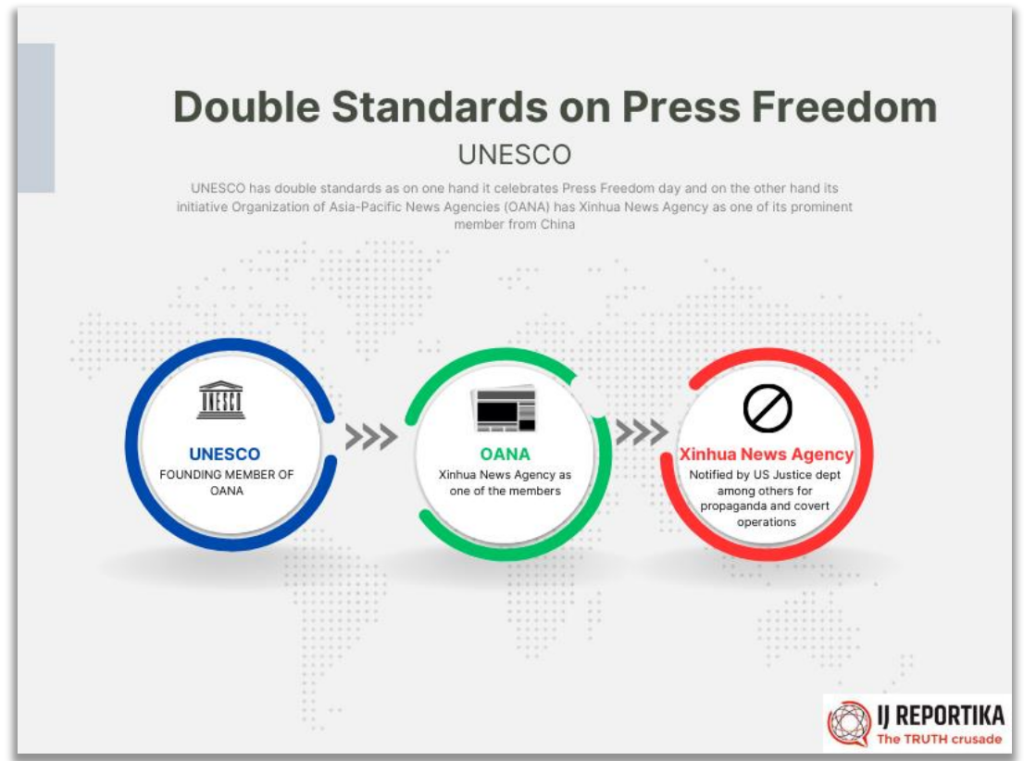
UNESCO, the United Nations Educational, Scientific and Cultural Organization, has been criticized for having double standards on press freedom. On one hand, UNESCO celebrates World Press Freedom Day, which is an annual event that honors the fundamental principles of press freedom. On the other hand, UNESCO is a member of the Organization of Asia-Pacific News Agencies (OANA), which includes the Xinhua News Agency, a state-run news agency in China that has been accused of censorship and propaganda.
UNESCO’s membership in OANA is hypocritical, given its commitment to press freedom. Xinhua News Agency has been accused of suppressing news that is critical of the Chinese government, and it has been used to spread disinformation and propaganda.
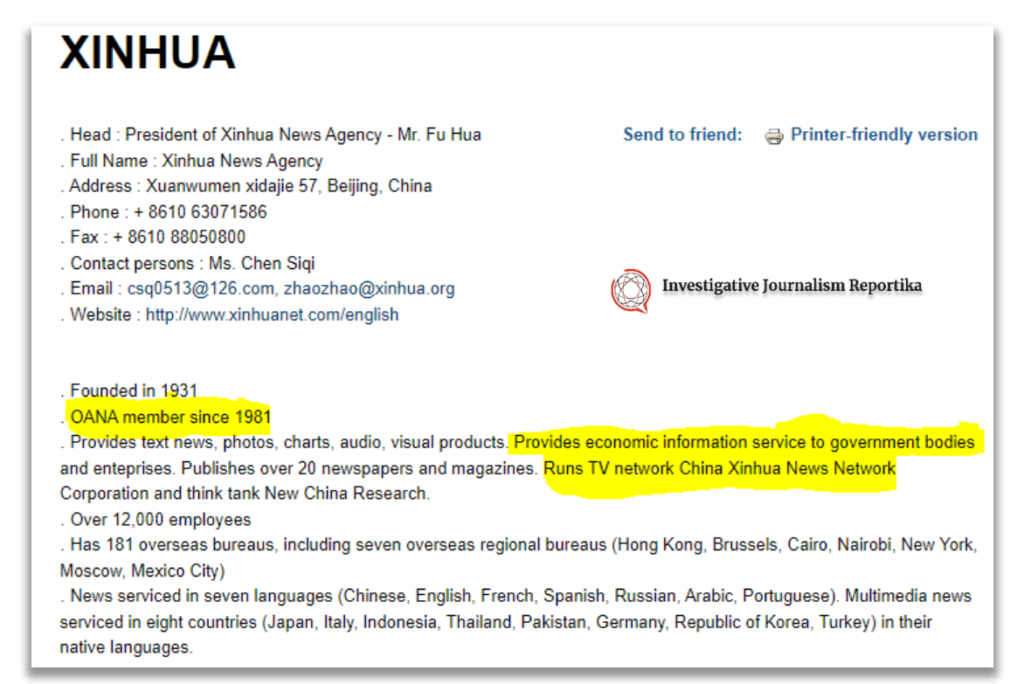
UNESCO has defended its membership in OANA, arguing that it is important to engage with all sides in order to promote press freedom. However, critics argue that UNESCO’s membership in OANA gives legitimacy to a news agency that is not committed to press freedom.
The issue of UNESCO’s double standards on press freedom is a complex one. However, it is clear that there is a need for UNESCO to be more transparent about its relationship with OANA and to take steps to ensure that its membership in OANA does not undermine its commitment to press freedom.
Reference: World Press Freedom Day, 3 May each year, to promote freedom of expression and freedom of the press as a basic human right and as crucial components of any healthy, democratic, and free society.
OANA
The Organization of Asia-Pacific News Agencies (OANA) was founded in Bangkok on December 22, 1961, at the First General Assembly of Asian news agencies on the initiative of UNESCO. The organization was formed to secure a direct and free exchange of news between the news agencies of a region inhabited by more than one-half of the world’s population. The Asia-Pacific countries account for 56 percent of the world’s gross product, some 50 percent of its trade turnover, over 60 percent of its maritime, and nearly 25 percent of air transport volume. The world’s largest financial reserves and science-intensive technologies are concentrated in the Asia-Pacific region. At present OANA brings together 44 news agencies from 35 countries. OANA members are responsible for two-thirds of information circulated throughout the world.

Read about the past controversies that engulfed the credibility of the international body in the complete report : The UNESCO Unveiled
Conclusion
Over the years, the influence of China and other countries on UNESCO has given rise to controversies, accusations, and even the withdrawal of nations like the USA from the international body. China’s influence, in particular, has raised concerns about the objectivity and independence of UNESCO’s decision-making processes, with allegations of political motivations and biases. To ensure a more democratic and impartial approach, UNESCO needs to address these concerns. Transparency in operations, especially in matters like the selection and evaluation of World Heritage Sites, is crucial to alleviate suspicions of undue political influence. Additionally, diversifying the leadership and decision-making bodies within UNESCO, reducing the dominance of specific countries, can help mitigate the disproportionate influence of any single nation. By fostering an environment that promotes open dialogue, values diverse perspectives, and upholds principles of human rights and cultural diversity, UNESCO can enhance its credibility and free itself from undue influence. Such steps are necessary to preserve and promote cultural heritage, foster global peace, and uphold UNESCO’s mission on a truly unbiased and inclusive platform.


